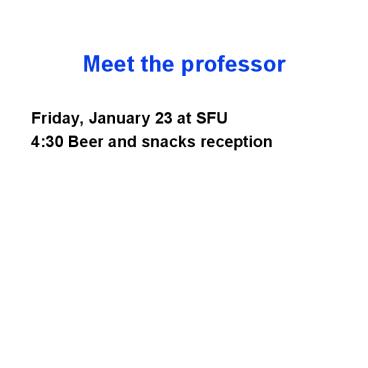Meet the professor PowerPoint PPT Presentation
1 / 39
Title: Meet the professor
1
Meet the professor
- Friday, January 23 at SFU
- 430 Beer and snacks reception
2
Spatial Covariance
NRCSE
3
Valid covariance functions
- Bochners theorem The class of covariance
functions is the class of positive definite
functions C - Why?
4
Spectral representation
- By the spectral representation any isotropic
continuous correlation on Rd is of the form - By isotropy, the expectation depends only on the
distribution G of . - Let Y be uniform on the unit sphere. Then
5
Isotropic correlation
- Jv(u) is a Bessel function of the first kind and
order v. - Hence
- and in the case d2
- (Hankel transform)
6
The Bessel function J0
0.403
7
The exponential correlation
- A commonly used correlation function is ?(v)
ev/?. Corresponds to a Gaussian process with
continuous but not differentiable sample paths. - More generally, ?(v) c(v0) (1-c)ev/? has a
nugget c, corresponding to measurement error and
spatial correlation at small distances. - All isotropic correlations are a mixture of a
nugget and a continuous isotropic correlation.
8
The squared exponential
- Using yields
- corresponding to an underlying Gaussian field
with analytic paths. - This is sometimes called the Gaussian covariance,
for no really good reason. - A generalization is the power(ed) exponential
correlation function,
9
The spherical
- Corresponding variogram
nugget
sill
range
10
(No Transcript)
11
The Matérn class
- where is a modified Bessel function of
the third kind and order ?. It corresponds to a
spatial field with ?1 continuous derivatives - ?1/2 is exponential
- ?1 is Whittles spatial correlation
- yields squared exponential.
12
(No Transcript)
13
Some other covariance/variogram families
Name Covariance Variogram
Wave
Rational quadratic
Linear None
Power law None
14
Estimation of variograms
- Recall
- Method of moments square of all pairwise
differences, smoothed over lag bins - Problems Not necessarily a valid variogram
- Not very robust
15
A robust empirical variogram estimator
- (Z(x)-Z(y))2 is chi-squared for Gaussian data
- Fourth root is variance stabilizing
- Cressie and Hawkins
16
Least squares
- Minimize
- Alternatives
- fourth root transformation
- weighting by 1/?2
- generalized least squares
17
Maximum likelihood
- ZNn(?,?) ? ??(si-sj?) ? V(?)
- Maximize
- and q maximizes the profile likelihood
18
A peculiar ml fit
19
Some more fits
20
All together now...
21
Asymptotics
- Increasing domain asymptotics let region of
interest grow. Station density stays the same - Bad estimation at short distances, but
effectively independent blocks far apart - Infill asymptotics let station density grow,
keeping region fixed. - Good estimates at short distances. No effectively
independent blocks, so technically trickier
22
Steins result
- Covariance functions C0 and C1 are compatible if
their Gaussian measures are mutually absolutely
continuous. Sample at si, i1,...,n, predict at
s (limit point of sampling points). Let ei(n) be
kriging prediction error at s for Ci, and V0 the
variance under C0 of some random variable. - If limnV0(e0(n))0, then
23
The Fourier transform
24
Properties of Fourier transforms
- Convolution
- Scaling
- Translation
25
Parcevals theorem
- Relates space integration to frequency
integration. Decomposes variability.
26
Aliasing
- Observe field at lattice of spacing ?.
Since - the frequencies ? and ??2?m/??are aliases of
each other, and indistinguishable. - The highest distinguishable frequency is ???, the
Nyquist frequency.
27
Illustration of aliasing
- Aliasing applet
28
Spectral representation
- Stationary processes
- Spectral process Y has stationary increments
- If F has a density f, it is called the spectral
density.
29
Estimating the spectrum
- For process observed on nxn grid, estimate
spectrum by periodogram - Equivalent to DFT of sample covariance
30
Properties of the periodogram
- Periodogram values at Fourier frequencies
(j,k)????are - uncorrelated
- asymptotically unbiased
- not consistent
- To get a consistent estimate of the spectrum,
smooth over nearby frequencies
31
Some common isotropic spectra
- Squared exponential
- Matérn
32
A simulated process
33
Thetford canopy heights
- 39-year thinned commercial plantation of Scots
pine in Thetford Forest, UK - Density 1000 trees/ha
- 36m x 120m area surveyed for crown height
- Focus on 32 x 32 subset
34
Spectrum of canopy heights
35
Whittle likelihood
- Approximation to Gaussian likelihood using
periodogram - where the sum is over Fourier frequencies,
avoiding 0, and f is the spectral density - Takes O(N logN) operations to calculate
- instead of O(N3).
36
Using non-gridded data
- Consider
- where
- Then Y is stationary with spectral density
- Viewing Y as a lattice process, it has spectral
density
37
Estimation
- Let
- where Jx is the grid square with center x and nx
is the number of sites in the square. Define the
tapered periodogram - where . The Whittle
likelihood is approximately
38
A simulated example
39
Estimated variogram

